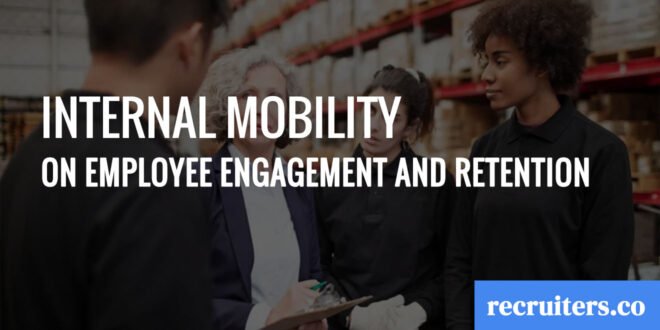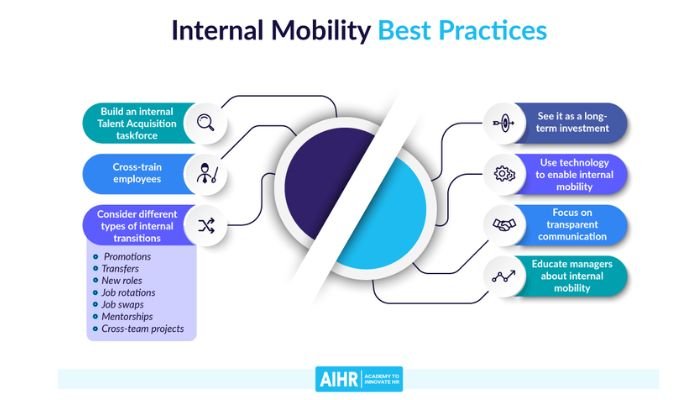Impact of Internal Mobility on Employee Engagement and Retention

The success and growth of any organization rely heavily on its ability to attract, engage, and retain top talent. Internal mobility has become an increasingly important factor in achieving these organizational goals. Internal mobility refers to the movement or transfer of employees within an organization from one job or department to another.
This blog will examine how internal mobility significantly enhances employee engagement and retention, underscoring considerations of strategy, challenges, and potential drawbacks in its implementation for successful outcomes.
By understanding different methods and structures for facilitating internal mobility as well as examining benefits offered both to employers and employees alike, organizations are better equipped to employ strategies that empower and nurture continuous development among their workforce for mutual benefit.
Internal Mobility
Internal mobility refers to the process where individuals are redeployed horizontally, vertically, or diagonally within an organization. It can also be used to describe the ability for employees to flexibly move between roles while staying employed.
On a larger scale, internal mobility involves strategies and initiatives related to lateral transfers and promotions of staff between teams, departments, or locations.
Benefits of this type of Mobility include increased job satisfaction and motivation, improved employee loyalty and commitment, greater levels of engagement leading to enhanced productivity across organizations as well as opportunities for both career development and professional growth.
Different forms of internal mobility (horizontal, vertical, diagonal)
Internal mobility refers to the practice of helping employees continue their career development within an organization. There are three primary types of internal mobility: horizontal, vertical, and diagonal.
Horizontal internal mobility involves lateral movements between different functional areas or departments within an organization without a change in employee level or remuneration packages.
Vertical internal mobility implies supportive advancement opportunities which can cascade across multiple hierarchical levels such as promotions, stretch assignments, and specialist roles for individuals to progress up the managerial ladder.
Diagonal mobility envelops both variations to crosscut the hierarchy and can include strategic site shifts outside of HQ locations often accompanied by international relocations over extended periods – perhaps finite-term or embedded assignments with external clients/partners worldwide.
Benefits of internal mobility for organizations

Internal mobility offers organizations a wealth of benefits, including cost and time savings. It can unlock workers’ latent or hidden potential and provide greater innovation within the organization.
Most importantly, internal mobility allows employees to move freely on their career paths without leaving the company, generating improved employee engagement.
Employees are more likely to be satisfied in their jobs when they can progress along meaningful pathways that give them greater fulfillment than lateral moves would accomplish. This increases drive and productivity as well as loyalty towards an employer who provides this type of opportunity for career growth.
Employee Engagement

Employee engagement is the emotional commitment and connection to one’s organization, job, and tasks that motivate employees to do their best. It reflects enthusiasm, focus, attention, and motivation to contribute and/or stay within the current environment or organization.
A high degree of employee engagement in an organization creates benefits such as increased performance levels with innovative ideas; more satisfied customers resulting from higher quality products/services; better teamwork providing improved production deadlines; greater solidarity between differing departments leading to a stronger reputation in the market— all tying back important revenue gains that bolster multiple teams’ successes.
Factors influencing employee engagement

Employee engagement is the emotional or mental commitment an employee has to their role, the organization they work for, and value-driven activities that are meant to benefit both them and their employers.
To enhance employee engagement in any organization there are four main factors that must be considered- recognition, trust, autonomy, and motivation. Recognition provides employees with an appreciation for good performance while trust encourages honesty between managers and employees by giving them freedom to communicate openly.
A sense of autonomy allows staff members to take ownership of jobs and truly believe in their capacity when completing tasks.
Relationship between internal mobility and employee engagement
The relationship between internal mobility and employee engagement is established when employees have the opportunity to actively move across different roles within their organization.
Internal mobility offers a wide range of opportunities, including growth and development, increased job satisfaction, and developing or improving skills. Employees that are allowed to move into different areas gain valuable experiences which can make them more engaged while creating unique career paths for themselves.
Moreover, it provides recognition since organizations highly value people who demonstrate initiative in taking on new challenges and succeeding where other people might not have been able to achieve. Not only does internal mobility facilitate learning and exploring various facets of the business, but it also helps build employee loyalty as they move from role to role within the same organization.
Ultimately this promotes higher employee engagement rates due to greater job satisfaction, increased sense of belonging and ownership, as well as an overall more positive organizational culture.
Employee Retention

Employee retention is a measure of the ability of an organization to keep its employees over long periods of time. It requires good management practices and policies that foster job satisfaction, loyalty, investment in talent development, personal growth opportunities, and recognize successes.
Employee retention helps organizations retain experienced staff within their overall workforce structure while saving costs associated with further hiring/training processes. Additionally, it adds value to the organization’s hiring and onboarding process by ensuring new prospects have personnel to help acclimate them to company procedures.
Overall, employee retention is beneficial as a higher constituted of engaged employees directly leads to greater customer satisfaction ultimately benefitting company success levels.
Common challenges related to employee retention
Employee retention plays an important role in achieving success for any organization, but maintaining high employee engagement is becoming increasingly difficult due to trends of changing job performance, frequent turnover, and aging of workforce demographics.
- Common challenges related to employee retention include:
- How organizational culture influences behaviors; compensation and recognition related to production output
- Mentoring opportunities and support provided for promotions within the system; flexible working arrangements
- Resilience levels of current employees in today’s ever-changing environment
- Salary expectations compared with cost-cutting or wage stagnations systems as well driving healthy leadership styles.
Every challenge must acknowledge that all employees are different but the desired outcome remains the same—employee satisfaction, commitment, and loyalty.
Role of internal mobility in retaining employees
Employee retention often hinges on two factors: engagement and internal mobility. Internal mobility can play a big role in retaining employees, as it provides career advancement opportunities, continuous learning opportunities that foster skills development, and increased employee loyalty and commitment.
By offering the chance to transfer or be promoted within their existing organization, companies demonstrate that individuals are valued assets—a sentiment that bolsters an employee’s feeling of job security.
Companies will also benefit from sustained knowledge and institutional memory retained “in-house” should any one employee decide to leave the business. Overall, internal mobility positively increases workplace morale while allowing companies to better use the talent already present for long-term success.
Strategies for Enhancing Internal Mobility

1. Establishing a culture of internal mobility
Organizations can establish a culture of internal mobility by emphasizing the value it brings as well as the variety of opportunities available to employees. Developing an organizational mindset that encourages upskilling and internal job postings for early-career staff must be actively fostered at all levels, with senior leadership providing vision and buy-in.
Resources should be allocated to supporting different initiatives, from online courses to onsite workshops to help propel employees in the direction of their goals. Formal mentorship programs should also be a cornerstone providing guidance outside both traditional management structures and departments so employees can reach their professional aspirations within the organization.
2. Encouraging cross-functional collaboration
One of the best strategies for enhancing internal mobility is to encourage cross-functional collaboration. This can be achieved by enabling communication and interaction between different departments, equipping employees with multiple skill sets, developing an understanding of different job roles, forming teams dedicated to initiatives on more complex projects or tasks, adopting an open environment enabling constructive feedback, etc.
Cross-functional collaboration provides employees with opportunities to experience various aspects of their organization and gain insights from domains outside domains that would be hard to learn only through assignments in departmental silos.
It further allows them to remain abreast of the overall corporate objectives while still gaining deep expertise in tightly focused areas and encourages lateral thinking and broadened viewpoint which has been found to improve process innovation significantly.
3. Implementing mentorship and coaching programs
One of the key strategies for enhancing internal mobility is to implement mentorship and coaching programs. These initiatives through which more experienced employees can provide support by sharing insights, advice, and guidance with others, promote career growth by helping develop potential future leaders in the organization.
By promoting skills development, effective communication and collaboration amongst team members should be improved leading to overall higher employee retention rates.
Additionally, these programs will also increase employee engagement since opportunities are available for accelerated development and career progression not achievable otherwise. Lastly, having strong mentors implemented in the organization would create a sense of alliance within teams and ultimately lead to better organizational outcomes.
4. Providing clear career pathways and growth opportunities
Providing clear career pathways and growth opportunities is essential for effectively managing internal mobility. Organizations can set up long and short-term objectives to demonstrate the prospects of professional development, succession planning and enhance employee engagement within teams.
This involves ensuring employees have an understanding of the key steps taken to progress in their role or move between departments/teams that they may be suitable for.
By providing engaging development plans which map training, coaching even job shadowing tools such as professionals to gain further insight, moving internally will seem less unfamiliar; plus with timeline goals outlined it helps incentivize hardworking individuals.
5. Supporting employee development through training and education
Providing clear career pathways and growth opportunities is integral to successfully encouraging internal mobility among employees.
Creating role progression maps, detailed job descriptions, and regularly updated organizational structures contribute significantly towards communicating career possibilities within an organization to its workforce.
This enables potential upward or lateral movement while simultaneously removing the guesswork behind planning a new role or confirming future expectations of current roles.
Additionally, transparency into pipeline positions allows for employees to envision their development in at least the short distant future be it advances in responsibilities, pay scales supervision hierarchies, etc.
Conclusion
Internal mobility is an advantageous tool with many benefits for both employees and organizations. It helps support fruitful employee engagement by offering wider growth opportunities, higher job satisfaction, and a heightened sense of belonging and loyalty.
Moreover, enhanced internal mobility encourages better retention rates by assuring profound learning experiences consequent to advancement opportunities for existing employees.
Organizations prioritizing internal mobility strategies should therefore observe improvements in job satisfaction, and employee engagement, as well as an investment over time in their present workforces due to this form of career development with its long-term value potential.
- Mastering Internal Mobility: A Comprehensive Guide to Success - August 10, 2023
- Effective Recruiting Strategies in a Competitive Sales Labor Market - July 27, 2023
- 6 Essential Factors to Attract Top Talent - July 19, 2023
